AMD’s 5 GHz Turbo CPU in Retail: The FX-9590 and ASRock 990FX Extreme9 Review
by Ian Cutress on August 9, 2014 8:00 AM ESTMany thanks to...
We must thank the following companies for kindly providing hardware for our test bed:
Thank you to OCZ for providing us with PSUs and SSDs.
Thank you to G.Skill and ADATA for providing us with memory kits.
Thank you to Corsair for providing us with an AX1200i PSU, Corsair H80i CLC and DRAM.
Thank you to ASUS for providing us with the AMD HD7970 GPUs and some IO Testing kit.
Thank you to MSI for providing us with the NVIDIA GTX 770 Lightning GPUs.
Thank you to Rosewill for providing us with PSUs and RK-9100 keyboards.
Thank you to ASRock for providing us with some IO testing kit.
Test Setup
| Test Setup | |
| Processor |
AMD FX-9590 4 Modules, 8 Threads, 4.7 GHz, 5.0 GHz Turbo |
| Motherboards | ASRock 990FX Extreme9 |
| Cooling |
Corsair H80i Thermalright TRUE Copper |
| Power Supply |
OCZ 1250W Gold ZX Series Corsair AX1200i Platinum PSU |
| Memory | G.Skill RipjawsZ 4x4 GB DDR3-1866 9-11-9 Kit |
| Memory Settings | DDR3-1866 8-9-9 |
| Video Cards | MSI GTX 770 Lightning 2GB (1150/1202 Boost) |
| Video Drivers | NVIDIA Drivers 337 |
| Hard Drive | OCZ Vertex 3 256GB |
| Optical Drive | LG GH22NS50 |
| Case | Open Test Bed |
| Operating System | Windows 7 64-bit SP1 |
| USB 2/3 Testing | OCZ Vertex 3 240GB with SATA->USB Adaptor |
| WiFi Testing | D-Link DIR-865L 802.11ac Dual Band Router |
System Benchmarks
Power Consumption
Power consumption was tested on the system as a whole with a wall meter connected to the OCZ 1250W power supply, while in a single MSI GTX 770 Lightning GPU configuration. This power supply is Gold rated, and as I am in the UK on a 230-240 V supply, leads to ~75% efficiency > 50W, and 90%+ efficiency at 250W, which is suitable for both idle and multi-GPU loading. This method of power reading allows us to compare the power management of the UEFI and the board to supply components with power under load, and includes typical PSU losses due to efficiency. These are the real world values that consumers may expect from a typical system (minus the monitor) using this motherboard.
While this method for power measurement may not be ideal, and you feel these numbers are not representative due to the high wattage power supply being used (we use the same PSU to remain consistent over a series of reviews, and the fact that some boards on our test bed get tested with three or four high powered GPUs), the important point to take away is the relationship between the numbers. These boards are all under the same conditions, and thus the differences between them should be easy to spot.
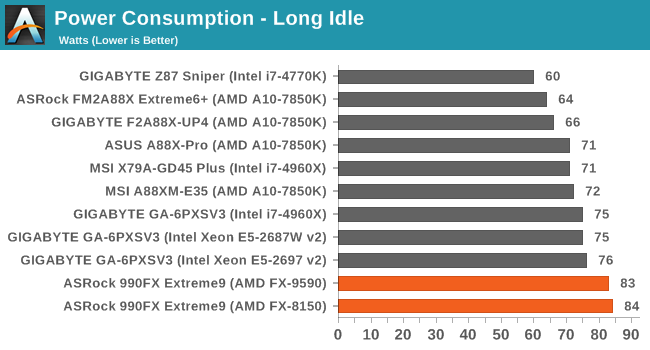
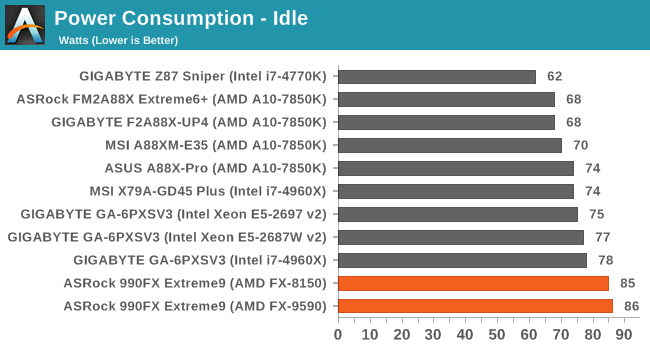
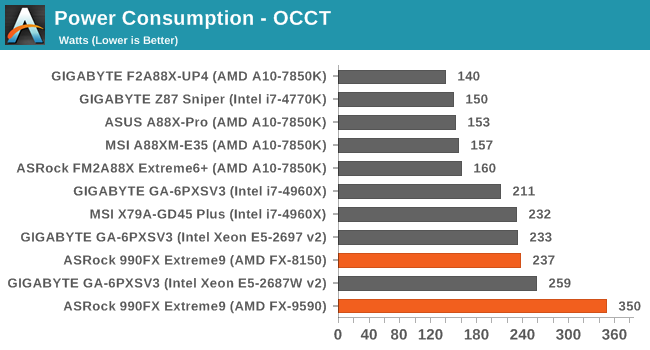
The added power draw of the FX-9590 is quite clear, showing 350W for the full system during a heavy CPU load. However, the idle power draw of the CPU is similar to that of the FX-8150.
Windows 7 POST Time
Different motherboards have different POST sequences before an operating system is initialized. A lot of this is dependent on the board itself, and POST boot time is determined by the controllers on board (and the sequence of how those extras are organized). As part of our testing, we are now going to look at the POST Boot Time - this is the time from pressing the ON button on the computer to when Windows 7 starts loading. (We discount Windows loading as it is highly variable given Windows specific features.) These results are subject to human error, so please allow +/- 1 second in these results.
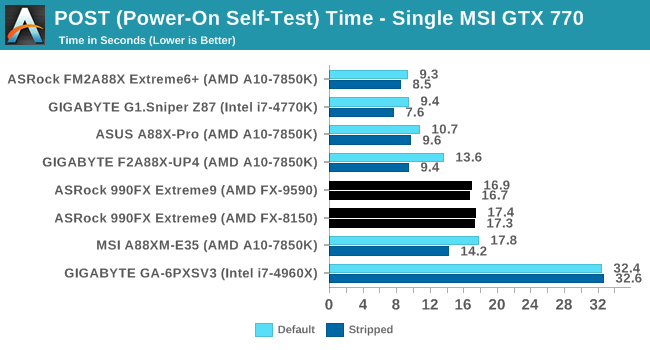
The FX-9590 afforded a shorter POST time than the FX-8150, although both are north of 16 seconds.
Rightmark Audio Analyzer 6.2.5
The premise behind Rightmark:AA is to test the input and output of the audio system to determine noise levels, range, harmonic distortion, stereo crosstalk and so forth. Rightmark:AA should indicate how well the sound system is built and isolated from electrical interference (either internally or externally). For this test we connect the Line Out to the Line In using a short six inch 3.5mm to 3.5mm high-quality jack, turn the OS speaker volume to 100%, and run the Rightmark default test suite at 192 kHz, 24-bit. The OS is tuned to 192 kHz/24-bit input and output, and the Line-In volume is adjusted until we have the best RMAA value in the mini-pretest. We look specifically at the Dynamic Range of the audio codec used on board, as well as the Total Harmonic Distortion + Noise.
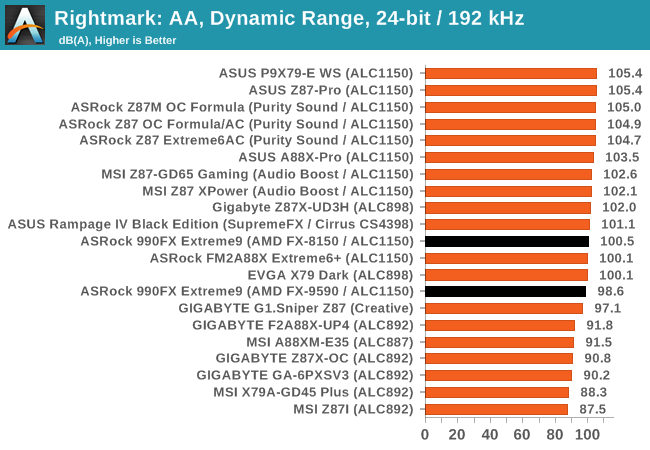
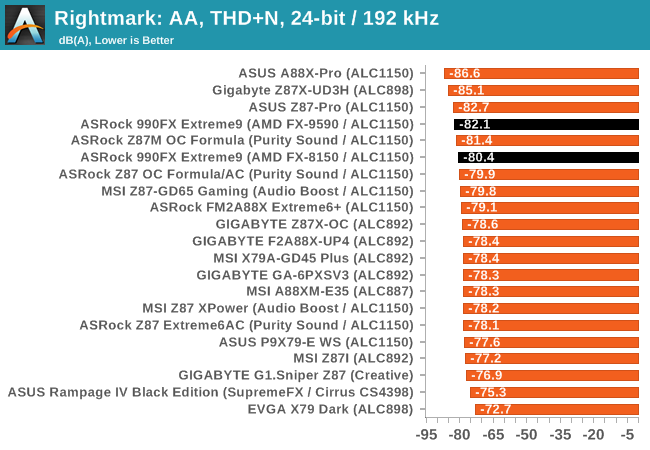
USB Backup
For this benchmark, we run CrystalDiskMark to determine the ideal sequential read and write speeds for the USB port using our 240 GB OCZ Vertex3 SSD with a SATA 6 Gbps to USB 3.0 converter. Then we transfer a set size of files from the SSD to the USB drive using DiskBench, which monitors the time taken to transfer. The files transferred are a 1.52 GB set of 2867 files across 320 folders – 95% of these files are small typical website files, and the rest (90% of the size) are the videos used in the WinRAR test. In an update to pre-Z87 testing, we also run MaxCPU to load up one of the threads during the test which improves general performance up to 15% by causing all the internal pathways to run at full speed.
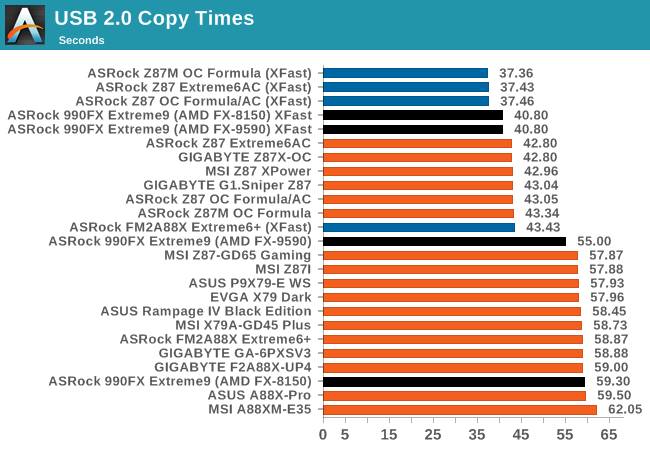
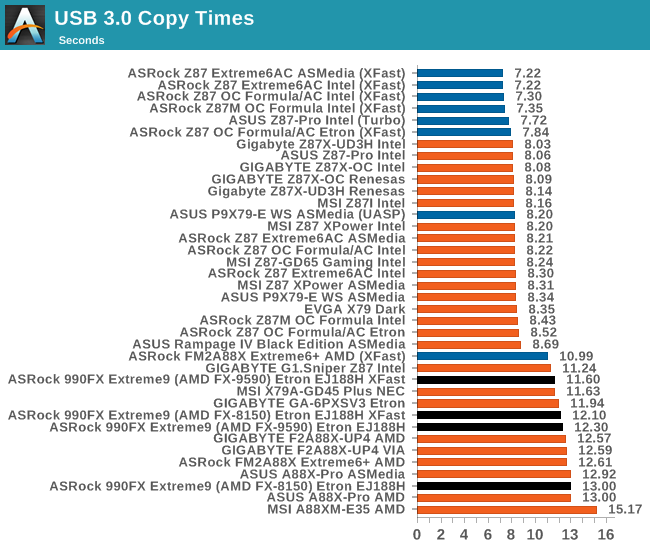
The increase in CPU speed of the FX-9590 gives a measured improvement in standard USB copy times – saving 4.3 seconds over the FX-8150 for USB 2.0 transfers. However using XFast USB eliminated that difference completely. For USB 3.0 transfers, using the Etron controller put a consistent advantage on the side of the FX-9590.
DPC Latency
Deferred Procedure Call latency is a way in which Windows handles interrupt servicing. In order to wait for a processor to acknowledge the request, the system will queue all interrupt requests by priority. Critical interrupts will be handled as soon as possible, whereas lesser priority requests, such as audio, will be further down the line. So if the audio device requires data, it will have to wait until the request is processed before the buffer is filled. If the device drivers of higher priority components in a system are poorly implemented, this can cause delays in request scheduling and process time, resulting in an empty audio buffer – this leads to characteristic audible pauses, pops and clicks. Having a bigger buffer and correctly implemented system drivers obviously helps in this regard. The DPC latency checker measures how much time is processing DPCs from driver invocation – the lower the value will result in better audio transfer at smaller buffer sizes. Results are measured in microseconds and taken as the peak latency while cycling through a series of short HD videos - less than 500 microseconds usually gets the green light, but the lower the better.
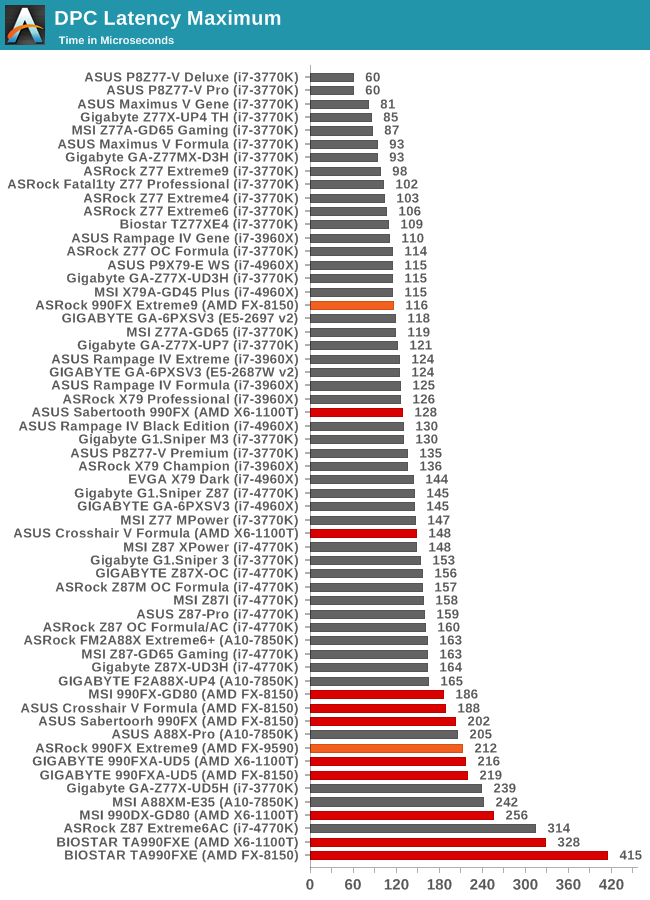
In a surprising twist, it would seem the FX-9590 has a disadvantage for DPC latency. I would have expected the faster processor to have the lower result, but one might speculate that the BIOS is tuned more for the mainstream processors such as the FX-8150. The chipset might also be geared more to the FX-8150 as it was the earlier generation compared to the FX-9590.










146 Comments
View All Comments
NeatOman - Saturday, August 9, 2014 - link
I have a FX-8320 @4.5Ghz, and never goes over 75c. I got it because it was $215 for both the CPU and a very good motherboard, and paired it with two HD 7850's. With that said, an overclocked i5@4.4Ghz is better then anything AMD can do over clocked even @5Ghz (for the most part) and at times far out classes it. But, an i5 and good motherboard will cost about $350 and $400+ for i7.. Almost twice. FYI, I live in Illinois and the electricity here is very very cheap.colinstu - Saturday, August 9, 2014 - link
a $300+ AMD chip?! LOL. Who the heck would buy this? It's not efficient, it's definitely not fast compared to $100 cheaper intel offerings (or similarly priced offerings in some of the other benches).swizeus - Saturday, August 9, 2014 - link
Second your opinion... It has been 3rd generation (or more ?) since FX gone out the door and AMD should have a solution to at least match Intel's performance by now, but why this ? It is pointless to have a power hungry beast that lost in the match with a processor that is halved in TDP in an Unzipping archive operation, not to mention electricity bill and the noise to cool down 220Watt TDP Processor... Not worth itRussianSensation - Sunday, August 10, 2014 - link
The amount of generations or the time span doesn't have any correlation with AMD catching up. Take an i7 4790K and manufacture it in 28-32nm node and see how awful it is. In other words, unless AMD can manufacture chips on the same node as Intel, it has no chance of competing whatsoever even if by magic their CPUs had identical IPC and clocks to Intel's. The delta in performance and performance/watt will only grow once Intel launches Skylake on 14nm next year.Budburnicus - Wednesday, March 11, 2015 - link
Umm a 4790K even at 32nm would still spank this chip across the board. How "awful" indeed...I mean forget the 4790K for a second, the 2600K at STOCK will beat this CPU out in nearly everything. and basically any i7-2600k on any board that supports overclocking WILL easily hit 4.2-4.4 - hell I had mine at 4.4 with a STOCK POS Intel Heatsink (POS in terms of its ability to cool, it is actually more than effective enough with how little heat the CPUs generate) - And at those speeds the 2600K beats out any and every AMD consumer CPU at almost everything, and what few benchmarks it will be behind in, it will not be by too much. And those benchmarks would include only VERY highly multithreaded applications of computational power - basically, server-type stuff. Certainly not in gaming!
Then there's the NEWER Intel CPUs like the i7-5930K (which I also own) which aren't too much more expensive than this flop, and will beat it out in absolutely anything and everything - at stock clocks again! With the exact same CoolerMaster Hyper 212 EVO I have on my i7-2600K machine (AWESOME cooler for the money, though I will probably replace the one currently on the 5930, as it does not provide the maximum OC headroom possible like it does on my 2600 machine) - with dual fans, I have all cores running totally stable at 4.4 GHz with 105.7 Bclock!
AMD really needs to dump this architecture for the consumer class entirely (though I admittedly am not too familiar with Server-class CPU benchmarks, from what I have read the newer Intel Xeon are spanking the current Opterons, but IIRC they still represent good value for money in the high end workstation and server classes - though Enthusiasts generally seem to stick with the Xeons as they like to be able to game at insane speeds and resolutions as well as do encoding, editing, CAD, etc. As I have seen quite a few "ULTIMATE Rig builds" where money is no issue, by people like NCIX, Linus Tech tips, PCper, and others on YouTube, but I have yet to see an ultimate Opteron machine)
So, yeah... All that speaks volumes to people who look at information objectively and without bias. IF AMD were to come out with a new chip tomorrow which not only spanked everything Intel has ever made, but also made it cheap like the original SandyBridge parts - and therefore changed the game, DAMNED right I would be coveting a brand new AMD rig, and would likely sell off my 2600K machine, despite my deep love for it (and the fact that it games slightly better than the 5930 due to higher core speeds by a decent bit) to try to fund such a build ASAP!
But as it is? You would have to be a blind fanboy to buy a CPU like this for a brand new build, as it does not perform well and eats power like crazy, requiring AMD to bundle a friggen AIO water-block with it! And even with the best of the best, it will BARELY overclock! So the stock speed benchmarks will never be too far from a sustainable, stable, overclock - a FAR different story from the i5-i7 2000-5000 K series CPUs - as I said, a pretty average overclock on an i7-2600K is 4.2 GHz, a full 1 GHz above stock speeds, as the 3.8 GHz turbo only works when a single core is under load, and even then it will still beat out tthis 5950 in most ways!
lurker22 - Saturday, August 9, 2014 - link
Is AMD even trying anymore? That power draw is PATHETIC in the year 2014xdrol - Saturday, August 9, 2014 - link
I think the fact that this very processor is still 'the' flagship shows that no, they are not even trying.TiGr1982 - Saturday, August 9, 2014 - link
No, they actually don't. This is just cherry-picked and overclocked FX-8350 from October 2012 with all the associated power draw and heat growing superlinearly because of the much higher operating voltage.However, AMD does develop their CPU side of the business, but since Kaveri this January the results go only into APUs (same will happen with Carrizo coming next year).
AMD APUs are actually very fine in their class, they are just in a shy situation regarding these factory overclocked 220W FXes. The rest of their lineup is fine.
StrangerGuy - Saturday, August 9, 2014 - link
300W alone for a CPU, holy mother of god. An entire Haswell gaming rig with 750 Ti would probably draw less power.BTW $250 is insane for any motherboard let alone an AMD one. That's an i5 4590 and a budget mobo right there already.
Daniel Egger - Saturday, August 9, 2014 - link
> 300W alone for a CPU, holy mother of god. An entire Haswell gaming rig with 750 Ti would probably draw less power.Don't know where you got that 300W from but yes, a decent Haswell system with 750 TI will not just probably but definitely draw less power than 300W. Mine takes around 35W idle and up to 120W in games.